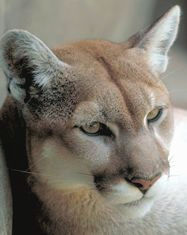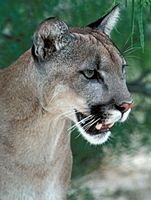Mountain Lion (Puma concolor)
- Description
Body length: 3 to 4 ft. Tail: 2.5 to 3 ft. Height at shoulder: 25 to 30 in. Weight: 70 to170 lbs.
The Mountain Lion is a large, slender cat with a smallish head and noticeably long tail. Its fur is a light, tawny brown color which can appear gray or almost black, depending on light conditions. Contrary to popular belief, there are no black panthers in North America; no one has ever captured or killed a black Mountain Lion. Mountain Lions are also called cougars, pumas, panthers, painters, and catamounts.
For more information see:
- Life History
- Mountain Lions are relatively uncommon, secretive animals. They are carnivores that prey on a variety of animals; some favorites include deer and wild hogs. Other prey animals included in the Mountain Lion's diet are rabbits, jackrabbits, javelinas, and rodents. Some lions occasionally kill livestock or dogs.
The Mountain Lion is solitary, except during breeding. Their young (typically 2-3 cubs) can be born almost any time of the year. Females usually breed every two to three years. - Habitat
- Mountain Lions generally are found in remote mountains, canyonlands, or hilly areas with good cover.
- Distribution
- The Mountain Lion has the widest distribution of any wild cat, from Canada to South America. Formerly distributed throughout North America, the Mountain Lion is now found mostly in the remote areas of the western U.S., as well as western Canada and much of Mexico. A small population still exists in southern Florida, where the species is considered endangered.
In Texas, the Mountain Lion is found throughout the Trans-Pecos, as well as the brushlands of south Texas and portions of the Hill Country.

